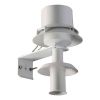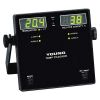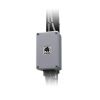YOUNG Temperature Sensors
Features
- Precision platinum RTD temperature sensor
- Easily installs in naturally ventilated (multi-plate) and aspirated radiation shields
- Junction box is provided for cable terminations
- Free ground shipping
- Expedited repair and warranty service
- Lifetime technical support
- More
Overview
The RM Young 41342 temperature probe offers high-accuracy temperature measurements. The 1000 ohm Platinum RTD temperature sensor is mounted in a weatherproof junction box for convenient wiring. Three output options are available, including 4 wire RTD, 0-1 VDC, and 4-20mA.
Deployment
For accurate measurements, the temperature probe should be installed in a protective radiation shield. Use of the probe without a radiation shield may result in large errors due to solar heating. The probe installs easily in the Model 41003P naturally ventilated or Model 43502 aspirated shield.
Maintenance
The temperature probe is designed to offer years of service with minimal maintenance. If necessary, the probe may be periodically checked or recalibrated using normal bath calibration methods. NIST-traceable calibrations are available from RM Young at an additional cost.
In The News
UNC's industry-standard water quality profiling platforms get upgrade
The University of North Carolina Institute Of Marine Sciences has a history with profiling platforms. UNC engineers and scientists have been building the research floaters for 10 years in a lab run by in Rick Luettich, director of the institute. UNC scientists and engineers developed their own autonomous vertical profilers to take water quality readings throughout the water column. They have three profilers placed in the New and Neuse rivers. The profilers are designed to drop a payload of sensors to an allotted depth at set time intervals. Instruments attached take readings continuously on the way down and up. Data collected by the profilers has been used to study water related issues such as infectious disease and sediment suspension.
Read MoreUSGS weather station network monitors Arctic Alaska's climate
When the U.S. Geological Survey began building their climate and permafrost monitoring network in Arctic Alaska in 1998, there wasn't much precedent for how to build the infrastructure for the instruments in the region's unforgiving environment. That meant the scientists had to learn the particulars on the fly. For example: On the great expanse of flat, barren tundra, a weather station sticks out like a sore thumb to a curious grizzly bear. "The initial stations were pretty fragile," said Frank Urban, a geologist with the USGS Geosciences and Environmental Change Science Center. "So the bear and those stations--the bear won every single time without any problem.
Read MoreFrom Paddles to Phytoplankton: Studying Vermont’s Wildest Lakes
For six months of the year, Rachel Cray, a third-year PhD student at the Vermont Limnology Laboratory at the University of Vermont, lives between a microscope and her laptop, running data. For the other six months, she is hiking and canoeing four of Vermont’s lakes, collecting bi-weekly water samples. Cray studies algal phenology across four lakes in Vermont, US, that have low anthropogenic stress—or in other words, are very remote. Funded by the National Science Foundation Career Award to Dr. Mindy Morales, the lakes Cray researches part of the Vermont Sentinel Lakes Program, which studies 13 lakes in the area and, in turn, feeds into the Regional Monitoring Network, which operates in the Northeast and Midwest US.
Read More


















